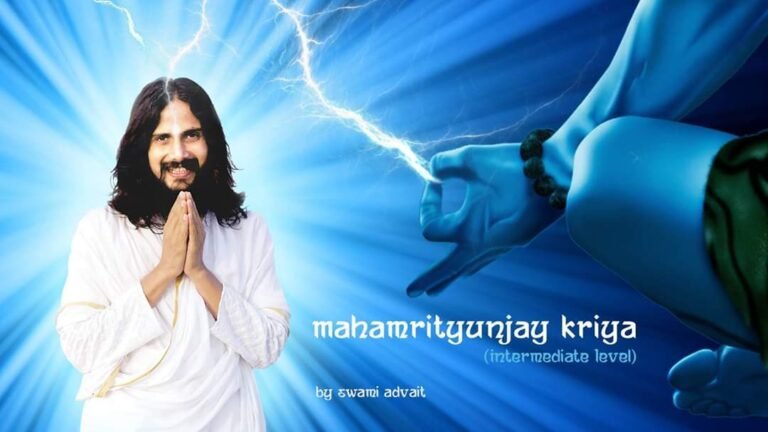
Welcome to the Mahamrityunjay Kriya. This Kriya includes breath work primarily and with the breath there is movement so exercise gets covered as well. The exercise is primarily stretching with a bit of aerobics, for example, running on one spot. The entire duration of the Kriya is ten hours and thirty six minutes. Seven hours is spent on breathing and three hours and thirty six minutes is spent on witnessing, silent sitting. After we have done the breath work we go into sitting. In that sitting the body remains very frozen. No movement happens at all and with this we accomplish the posture in three hours and thirty six minutes. Which traditionally we call Aasan Sidh. Practically in everyday life ten hours and thirty six minutes are not possible so choose to do as much as you like. You can have as little as thirty seconds, one portion of it. Or generally I recommend at least fifteen minutes in a day. You can do it in the morning and you can also do it in the night before sleep. If you do this before sleep, sleep becomes deeper. So the timing is up to you. Generally speaking, one hour is good and it is worth it. The breathing primarily depends on what you would like to achieve. Initially, the breathing should be inhaling from the nose, exhaling from the mouth. Once the toxins are removed from the body and body purification is done then you breathe in through the nose and out through the nose as well. So mainly in this kriya you either inhale through the nose and exhale through the mouth, or inhale and exhale through the nose. In the second last stage of the kriya, the jaw movement, we then inhale through the mouth and also exhale through the mouth. In the last stage we finish with mantra chanting, inhaling from the mouth and uttering the sound automatically exhaling through the mouth. After the mantra an additional step is done, where we utter the question “Who I Am!?” with intensity. In Ujjayi breath, imagine the breath coming from the throat instead of the tip of the nose. Use Ujjayi breath when you practice aasans. You are breathing in from the throat and breathing out from the throat too. It would have a little sound. For better control you can also imagine the breath controlled from the hara. Deep long inhale, deep long exhale. The first principle in breathing is that it should be long and deep breathing. Second, it should be rhythmic. So it follows a rhythm. Third, it should not have a shallowness and no jerk in it. The pattern should not break, it should be continuous. And the fourth, no noise should come if possible. This is the ideal. To clean the lungs, at times you would do it fast so there would be noise, which is okay, that is different. Initially at times the breath would not be as deep as you start practicing. That’s okay, at that time the cleansing is happening. Our work is towards cleaning the lungs by the breath, the kidneys, the pores and the intestines. The kriya covers this from the toes to the head. Almost all main parts of the body. So cleansing work happens throughout the body. Stages in Mahamrityunjay Kriya:
In the first stage, we run in one spot. Body is loosened. Arms parallel to the ground. The legs should come high up towards the chest. Straight up for women. Up and to the side for men.
Run in one spot
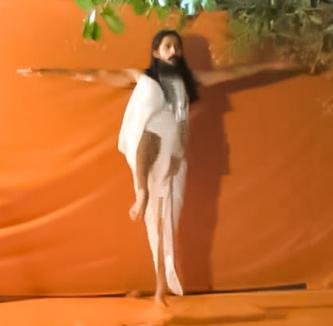
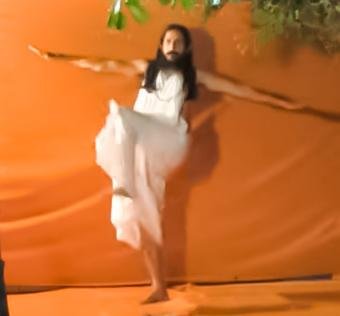
We do the remaining stages sitting down.
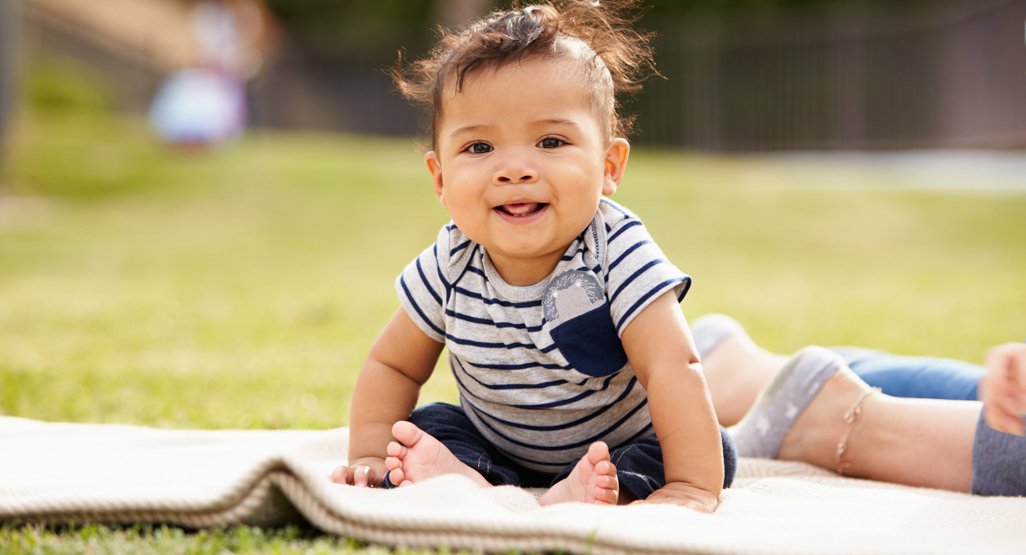
In the first stage of the sitting part, sit with the legs straight in front with the feet together. Rest the palms down on the floor with the arms close to the body and keep the back straight. As we breathe in through the nose, the toes curl in. As we breathe out (through the mouth and for those who have removed the toxins, through the nose), we straighten the toes again. In breathing in through the nose, we expand the upper lip and the jaw so the toxins in the jaw get removed. We open the air passage and then breathe in. If we just breathe without doing this, not much air goes in. Whereas, when you expand the upper lip, more air goes in. The more oxygen goes in, the more carbon dioxide comes out. We’ll be breathing like this throughout, except in the end when we inhale and exhale through the mouth. When there are more toxins to be removed and if you are doing it initially, then exhale through the mouth. Once you feel toxins are removed you can breathe out through the nose. (Except for the last two stages inhaling and exhaling through the mouth.) Choose one way how to do it and don’t alternate while you are doing the Kriya. Whichever you pick, either inhaling through the nose exhaling through the mouth or inhaling and exhaling, both through the nose, continue that throughout except for the last stages inhaling and exhaling through the mouth. Still in the second stage, sitting down, legs straight with the feet together, now inhale and rotate the feet together into one direction. As the feet rotate in the half going forward, exhale. When the feet rotate in the backward half coming back up, inhale. Then switch directions. Keep the feet together. The number of breaths could be anything and you decide on how long. Either you could choose to do it for one hundred rotations, or two hundred rotations, or fifty or twenty five. So that way, by counting, it also becomes easy because the mind gets something to hang onto counting and knowing how many times are still remaining. So first curling and stretching of the toes, second rotation the feet in one direction, third is the feet rotation in the other direction. In the fourth part, now the whole foot is stretched forwards, then backwards and towards the body, bending at the ankle. Breathe in as the feet stretch upwards and towards the body and breathe out as the feet stretch forwards. No curling of the toes here, move the whole foot.
Feet movement


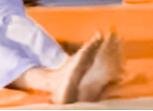
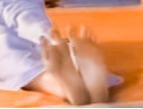
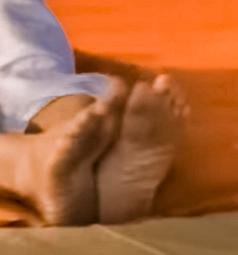
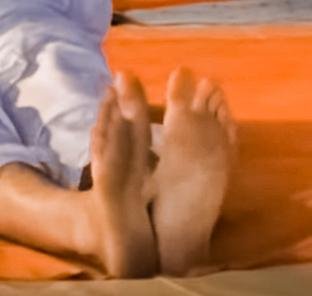
Moving forth, in the next stage breathe in and with both hands locked together underneath one thigh, lift this whole leg as high as you can and as it is lifted, allow the knee to bend naturally and the foot to fall towards the buttocks. When lifting, the top of the thigh should touch the chest and abdomen. Then breathe out as you kick the whole leg straight out in front of you. Repeat this movement. Then you take the other leg and do the same. Let’s say, if we are doing two hundred breaths, keep one hundred and fifty at the normal speed with full breathing and in the end for the last fifty breaths, the breath goes faster. This applies to both legs. And always when we exhale (except when I tell you specifically that it is only for lung cleansing) squeeze in the stomach so strongly that it could go close to the backbone so it’s going in all the way. Keep a smile on your face.
Single leg kick

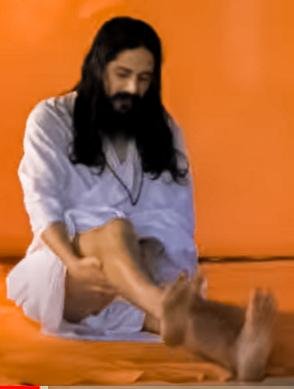
Legs Kick
In the next stage we kick both legs together. Lean backwards slightly while kicking both legs simultaneously in and out while using the arms stretched out in front of you and parallel to the ground to maintain balance. As you inhale, bring the legs in and as you exhale, kick the legs out.
Legs kick
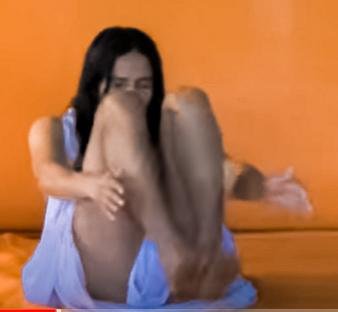
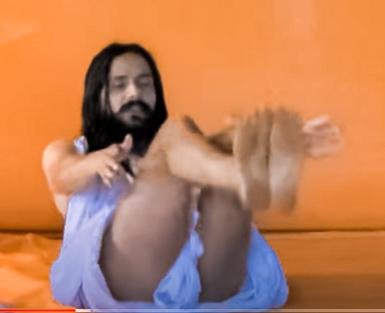
Upper Body Rotation
After using both the legs we go further up. Here if you can apply the lotus posture, then apply it. If you can’t apply the lotus posture, sit in half lotus or in easy posture or just put your legs in any which way so you can still do the movement. The point is that you should be sitting comfortably. The lotus posture gives more straightness to the back as well as other benefits. But if it is feeling painful then don’t sit like that. Try half lotus. Which leg to take up depends on the person. In whichever leg the nerves are softer, start with this one and take it up. Generally if you are right handed then the left leg is softer, those nerves are comparatively softer so you could start with this one or the opposite, whatever works for you. So we start from the middle. Same technique applies, breathing in, expanding the upper lip and the jaw and filling the lungs completely. Start rotating the spine in a circle around the hips. Inhale as you rotate in the backwards half coming up and exhale as you rotate in the forward half going down. After we have finished rotating in one direction we rotate in the other direction. We remember that the upper lip and jaw expand and then we exhale and continue rotating in the other direction. We do rotations in both directions.
Upper Body Rotation
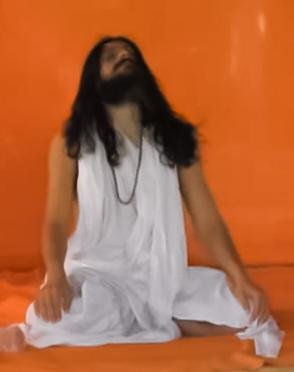
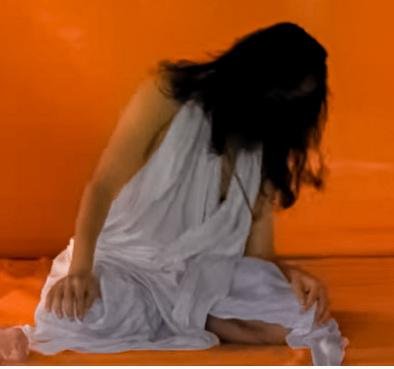
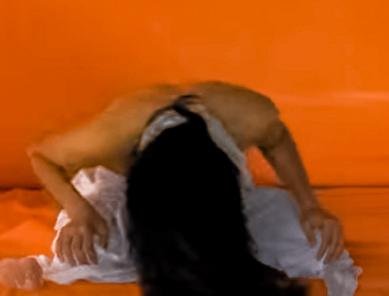
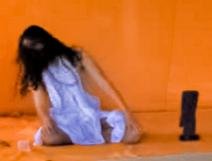
Torso Up & Down
For the third one we breathe in into the chest and, while keeping the back straight, lower our torso forwards. As low as we can without lifting the buttocks of the ground. We keep the hands lifted at the sides if possible. If you find it really difficult then you could also rest the hands on the knees with the palms facing upwards. Try to not touch the body with the fingers because comparatively more toxins would come from the fingers when doing this breath work. Try to keep the hands at the sides and then breathe. Bring the upper body back up. While doing it, maintaining the smile.
Torso Up & Down
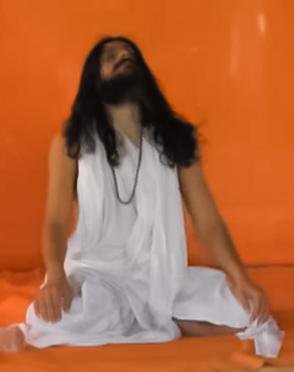
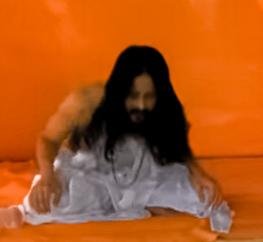
So these three, the rotations in both directions and the up and down movement of the upper body. These are the most important ones for massaging kundalini. It hits it directly. You can also spend a bit more time on these ones than on others. If you are doing all the other movements for two hundred breaths, this one you could do for three hundred. The two rotations and this up and down movement are most important for kundalini. The entire process is for kundalini awakening. This makes all the other body parts stronger and ready for it to happen. So that if it opens then we can handle it.
Throughout the process, when breathing out we apply the Moolbandh. The area between the private parts and the anus. So squeeze that in and then exhale. If it’s difficult for you to know where the Moolbandh is (some say Mullabanda, the correct pronunciation is Muhlbandh), you could just squeeze in the anus, the private parts and the area in between them both and then at the same time squeeze in the stomach. So all the way you squeeze it in and throw the air out. The air is going out. We do this process and apply the Moolbandh throughout the entire process on the exhale.
The 3 Bandhs
Let’s understand what a Bandh is and how to apply it, how to do it. The first Bandh is between the anus and the private part. The Moolbandh, root chakra. Before starting the bandh process, you either inhale or exhale fully. The breath retention on either inhalation or exhalation is the kumbhak. With this you apply the Moolbandh, the body parts as explained. You contract it, squeeze it, pull that part of the body inwards. Once you took it in, take the stomach in. Then the head goes down with the chin touching the chest. So put the head back slightly and then you tuck in the chin bringing the head down. These are your three Bandhs. If you can apply all three, it is best. If you find it difficult in the beginning, then only squeeze in the stomach and tuck in the chin, touching the chest. That is easier. So those two Bandhs are applied and then learn to apply the root chakra, the Moolbandh also. To apply the Bandhs we take all the air out exhaling fully through either the mouth or the nose. If we do it by the mouth then as if you are whistling, exhale all the air out. Once all the air is out, apply all three bands and hold it as long as you can. A very important thing is not to breathe in when the neck is down. No sudden jerk, that could harm you and go into some nerves in the brain and that could be extremely damaging. So once you bring the head back up and the neck is straight, then you breathe in. The best way to do this is by keeping a smile on your face and as the smiling gets disturbed, you reach your limit and you know you cannot hold the breath longer. So you bring the head up and then you breathe in.
The 3 Bandhs
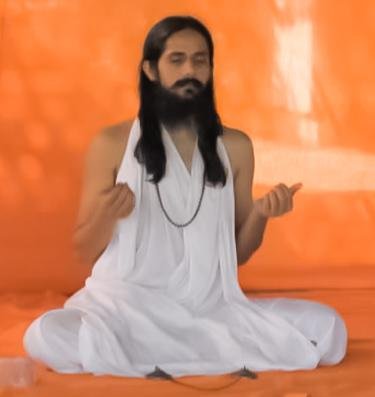
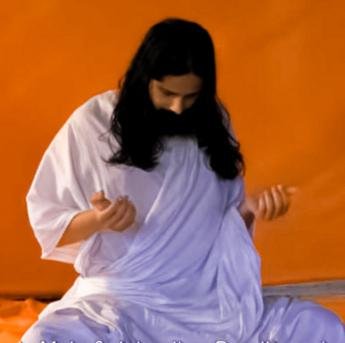
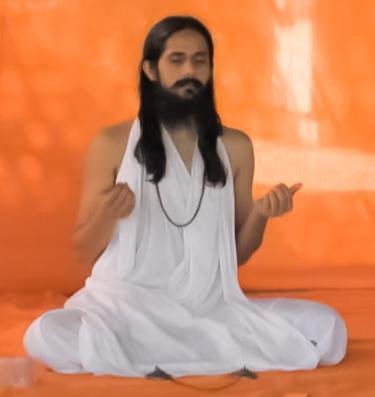
Cat Pose
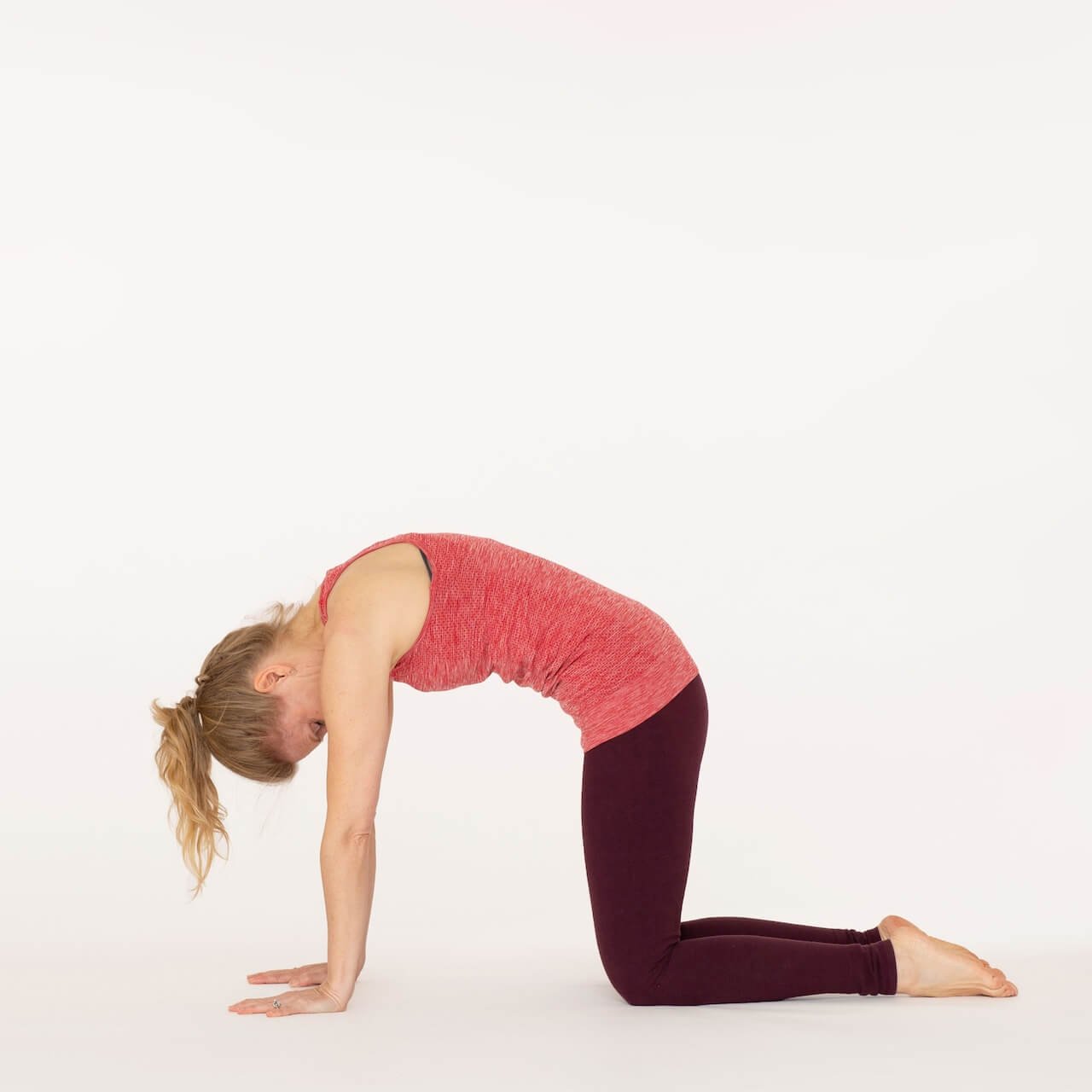
Going further, we’ll do the cat pose. In the cat pose we stand on all fours like a cat. With the palms planted on the ground in front and on the knees and feet on the ground behind. Exhale with the head up and facing forwards, inhale with head downwards with the chin touching the chest and the back slightly arched. When we exhale the same principle applies and we apply the root chakra, the Moolbandh.
Hands stretch
In the next step you sit down again in the lotus posture, half lotus, or whichever you had chosen previously that is not causing you pain. Now we come to shoulder and chest work. While sitting up straight extend the arms straight in front parallel to the ground. While exhaling, open the palms facing forwards with the hands perpendicular to the arms. When you inhale, make two fists while keeping the hands perpendicular to the arms. Repeat this movement.
Hands stretch
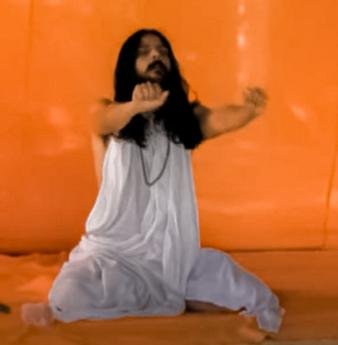
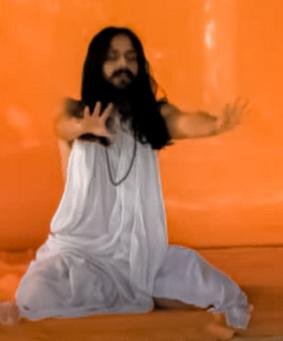
Rowing Arms
In the next stage, from there, as you inhale swiftly pull the arms back totally in a sideways motion while making fists. Similar to the motion of rowing a boat with both arms. Then we swiftly push the arms forward as we exhale. Here the hands remain open and perpendicular to the arms.
Rowing Arms
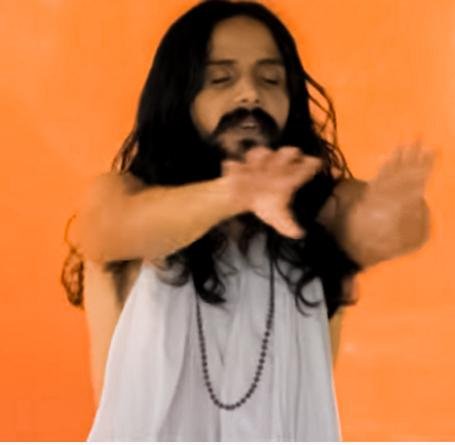
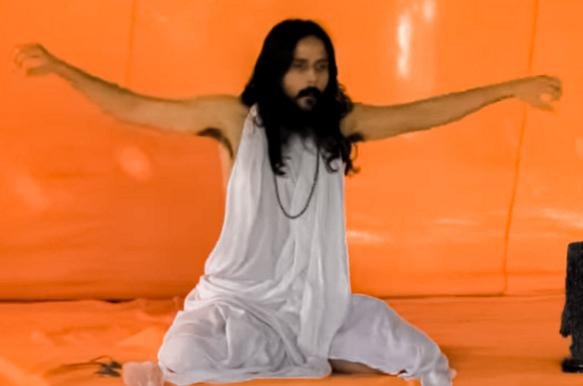
Arms back & forth
Next we fold in the arms and hands, here the palms are facing upwards, arms still stretched out in front and from there we throw the arms back hands moving towards shoulders as if we are throwing something out behind us. Inhale as arms are stretched out straight in front with the palms upwards, exhale as the elbows bend and hands move towards the shoulders.
Arms back/forth

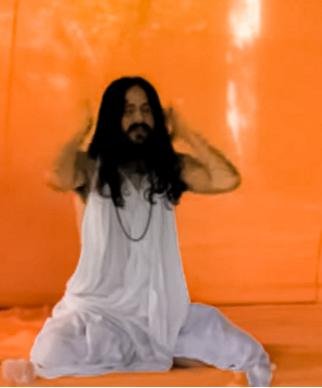
After this, stretch the arms out straight to each side parallel to the ground with the palms up. With the same motion as the previous exercise, bend the elbows as the hands come to the shoulders with the same inhale and exhale pattern as the previous movement as well.
Breath of Fire

Next, we hold the arms in front of us parallel to the ground with the elbows bent at a 90 degree angle. The hands are holding the Dhyan Mudra, tips of the thumb and index finger are touching and the other fingers are relaxed, palms facing towards the body. Then strongly exhale through the nose and from the belly. Focus on the exhale, inhale happens naturally.
Jupiter Movement
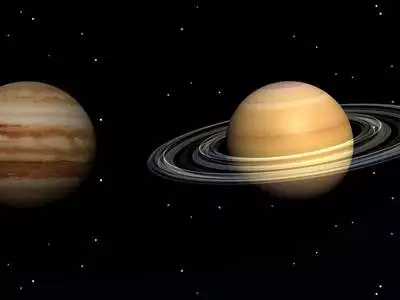
After this, while keeping the same mudra, have both hands floating comfortably in front of the body anywhere around the navel level. As you inhale, bring the right arm up near the left ear and make a horizontal circle around the back of the head to the other ear. Then while exhaling, bring the arm back down to the navel level. Do the same movement with the left arm and repeat both. Next, lift the arms up to the sides both held out straight and upwards at a 45 degree angle and breathe strongly and swiftly from the belly. Focus on exhale, inhale happens naturally.
Shoulder Rotation
After this, touch the shoulders with your hands with the elbows out in front. While keeping the hands on the shoulders, rotate the shoulders fully, as if they were wheels at the sides of the body. As the shoulders lift up in front, breathe in. As they go down behind, breathe out. Repeat this. Then switch the direction of the rotation. As the shoulders lift up in the back, breathe in. As they go down in front, breathe out. Hands are touching the shoulders the whole time. As you are nearing the end of each rotation speed of movement and breath can be increased too.
Shoulder Rotation

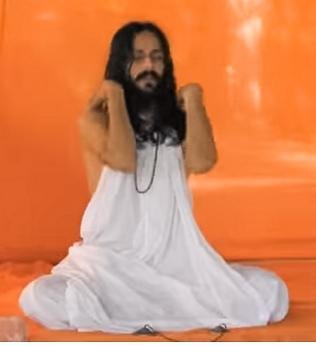

Arms Up & Down
After this, we keep the arms at the side of the upper body with elbows bent and closed fists. Breathe in, fill the lungs completely and then as you exhale, shoot the arms upwards and open the hands. The biceps should almost or slightly touch the ears if possible. Bring them down swiftly with the inhale as you bend the elbows and touch the triceps to the sides of the ribcage. The stomach should go in all the way when exhaling.
Arms Up/Down
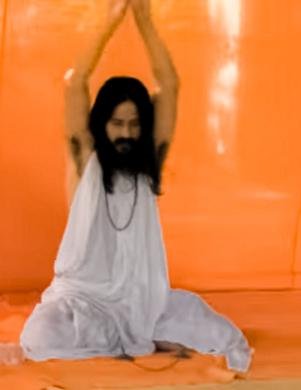
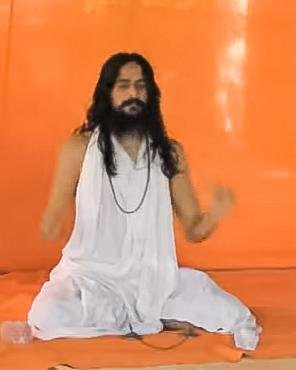
Next, we keep the same movement, but change the breath, exhaling as we bring the arms down, inhaling bringing the arms back up. We exhale so strongly that it touches our seventh chakra. Forget about the stomach, only exhale fully taking all air out and the rest will happen by itself.
Arms Up/Down 2
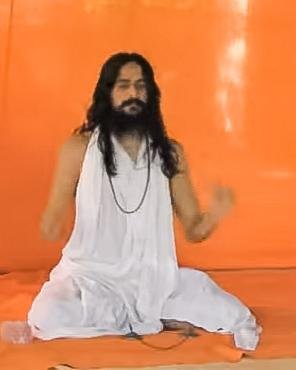
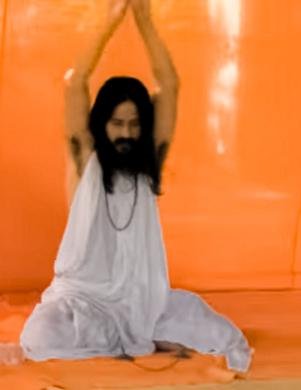
Head Rotation
After this we gently rotate the head, you take it to any one side and breathe in. Rotate the neck backwards as you expand the upper lip and the jaw and breathe in. Then when you come to the other side, breathe out and rotate the neck forwards. When the neck reaches to the shoulder on which you started, breathe in again and repeat this cycle. Once we have rotated in one direction we change directions and repeat the movement. The neck should not be jerked and should not have any kind of pain because the neck is very sensitive. So do the neck and head rotation carefully, gently and slowly.
Head Rotation
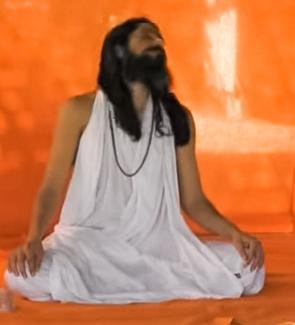
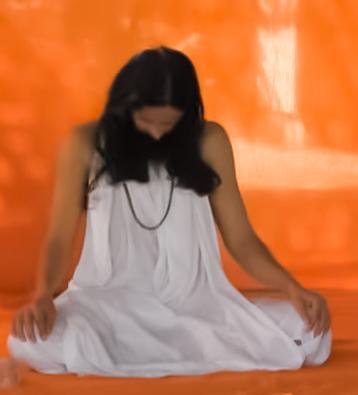
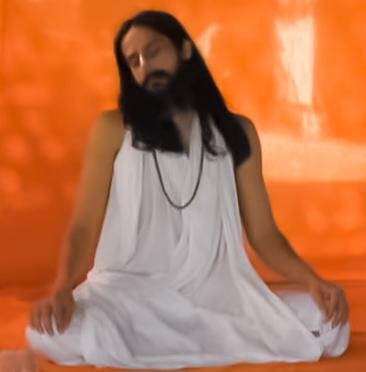
Jaw Movement
We move on to the jaw movement. Here the breath changes. Now we breathe in from the mouth and breathe out from the mouth. For this to happen, first thing, you open the mouth as much as you can. First open and once it’s open and you have taken the breath in, then to any one side you throw the air out. After the next inhale you throw the breath out on the other side and continue alternating sides with a strong inhale and strong exhale.
Jaw Movement
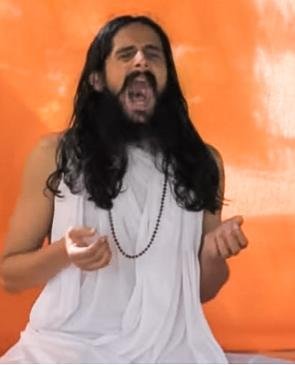


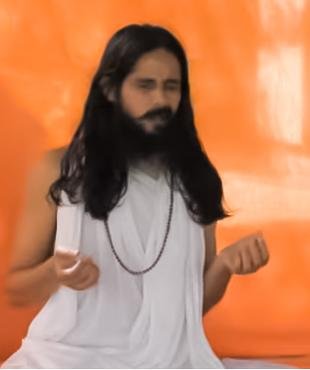
If you cannot make time in your entire work day, if you have five minutes, you can spend two minutes running on one spot and two minutes doing the jaw movement breathing. Then be still for a moment and just observe the sensations happening in your body and within. This itself will make a good start to the day and if the day starts good then you will create more good. This is most important. This can also be used in the night before sleep. The stomach should be empty. Before sleeping, do it for five minutes and then sleep. The sleep quality would be deeper.
Mantra Chanting
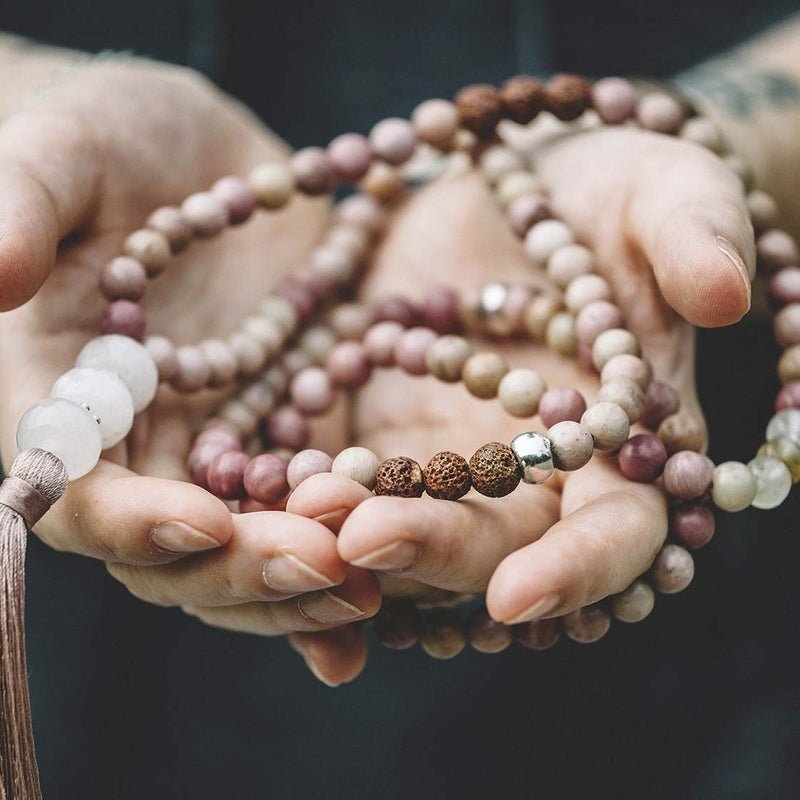
After this we do mantra chanting. Here also we changed the breath to inhaling from the mouth and exhaling from the mouth. We use the mantra “Alakh!” which is for bringing ecstaticness. It brings more activeness and at the same time, coolness. So you remain centered but at the same time also active. By this, in your day to day work, you get more energy and more spirit to do things. Chanting the mantra we breathe in from the mouth as we lift the head upwards to face the sky. Bringing the head down to the chest as much as possible we utter the sound, “ALAKH!” Throughout the process, the eyes remain closed. So you breathe in as you lift the head up and put it back, and just when you bring the head down you strongly utter “Alakh!” as you bring the chin towards the chest. We do not make the sound from the throat, we do it coming from the hara. When it is coming from the hara you also won’t have much of a problem with your throat or losing your voice. Make the sound using the hara, the center of our being. For different people different mantras work. Alakh is one sound. We could also use “So Hum.” You breathe in through the mouth putting your head back, silent “So”. You don’t say, “So”, it is silent and the in-breath. And while coming down you chant, “HUM! ” The in-breath “So” then happens automatically. You can choose “So Hum” and you can also choose “Hey Ram” if you like. “Hey” also happens when you breathe in from the mouth and it makes the silent sound of “Hey”. Same, you don’t say “Hey” aloud. Then when coming down you say, “RAM!” You could choose this mantra also. I recommend that initially you do Alakh because it reverberates in the whole being more powerfully and creates ecstaticness, giving instant energy. The best is always to experiment yourself and that which works we use. With this you could also use the word “Allah.” Same, you breathe in from the mouth putting your head up and back and utter “ALLAH!” intensely. You could also use “SHIV!” The process is the same, breathing in through the mouth and head back, then head forward and the chin touching the chest and saying the mantra out loudly. After this, if you wish to add on to your practice, this mantra is good: “Who Am I?” With this you ask yourself, who am I, where did I come from and where I will go. For “Who Am I?” you can follow the same head and neck movement as with the previous mantras. After some time, if the neck movement doesn’t happen anymore, that’s also okay. Continue saying loudly and intensely “WHO AM I!? WHO AM I!? WHO AM I!? WHO AM I!?….” With the sense of devotion and the question to ourselves, “Who am I? Where did I come from? Where will I go?” We do this strongly and with intensity. And keep the up and down head and neck movement on as much as possible. Totally surrendering to the process. Totally surrendering into the sound. Use Alakh and then add on Who Am I. Or use Alakh and after a few days or weeks change to Who am I. Or use Who am I instead of Alakh, if you wish to skip it. So this was the preparation for us to enter into meditation. After the Mantra you sit in meditation posture or lay down in savasan. The important thing is that you remain witness. Be still, freeze the body completely, no movement whatsoever. After the hard work of cleaning the body, now you can experience meditation. At this time, focus your energy making sure that one: the body remains totally still and frozen, second: stay witness. Witness so totally, be so alert in watching everything that is happening that no energy remains for thoughts. Once you freeze the body this would easily happen, you wouldn’t have thoughts. If some thought comes then do not go into the story of it. Witness it, don’t judge it and let it go, like a cloud passing in the sky. You could also say internally, “Stop nonsense! I don’t like it!” Or sometimes just, “STOP!” Inside, not out loud. Try this, say, “Stop nonsense! I don’t like it!” so the thought will go away. How? Let’s say if I have to lift this stone, first I instruct my hand, “Go there. Lift.” It happens so fast we don’t come to know. So in the same way you will say to the thoughts, “Stop!” they would go away. Then they would come again, then again say, “Stop!” But by the cleansing with kriya you have done, in this state you would have a lot less thoughts. Ninety percent of thoughts or ninety five percent of thoughts would be settled. And for those who will go into ecstasy, they will see the body separate and the soul separate. The body is lying down and the soul is somewhere outside. You will watch how the body is just lying there. We are not the body. If we do this intensely with all sincerity, the body and soul separation will happen. You will experience you are not the body. Before we even start Mahamrytyunjay Kriya, we can do a prayer. In this prayer we say, “With God as a witness, I make the strong determination that I will put all my energy in meditation.” We put our hands over the heart, say the prayer inside three times and after that we start the Kriya. The question is not about how much energy one needs to put into it generally. But as to our own capacity, as much energy as you have, you put all of that energy in, you give yourself totally, not leaving anything behind.

Give a Reply